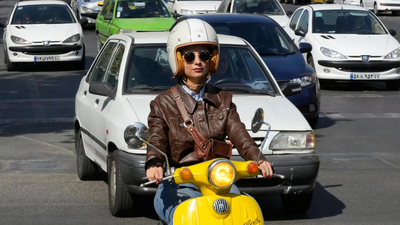
In Tehran’s dense traffic, where millions of cars and motorbikes jostle daily for space, a quiet transformation is taking shape. Women, long excluded from the city’s motorbike culture by regulation and taboo, are beginning to ride for themselves, an understated but telling act of defiance that challenges decades of convention in the Islamic Republic.
A ride against expectation
When 38-year-old café owner Merat Behnam first steered her yellow scooter through Tehran’s gridlocked streets, she expected hostility, not from the traffic but from those who might question her right to ride at all. In a city where women on motorbikes have long drawn disapproving looks and the threat of police intervention, her apprehension was understandable.What she found, however, was a measure of acceptance. Commuters mostly ignored her, while others looked on with curiosity rather than disdain. “It was a big deal for me. I didn’t really know how to go about it. In the beginning I was quite stressed, but gradually the way people treated me and their reactions encouraged me a lot.” She said, speaking to APHer decision to ride was not an overt political act. For Behnam, it was a practical response to Tehran’s congestion and the rising costs of car travel. Driving from her home in Sattarkhan, in the city’s west, had become exhausting and expensive, with parking scarcity and congestion charges of more than 20 million rials a month. “There is not any political manifesto or social agenda here,” she said simply. “It’s just that the traffic and parking issues were driving me crazy.”For decades, two barriers, legal and cultural, have kept Iranian women off motorbikes. The first lies in the language of the law itself. Official regulations specify that only “mardan” (men) may obtain motorcycle licences. In a language otherwise largely gender-neutral, the wording is explicit.“This issue is not a violation but a crime,” General Abulfazl Mousavipoor, Tehran’s traffic police chief, declared in September. “My colleagues will deal with these individuals, since none of these women currently have a driver’s licence and we cannot act against the law.” His comments, carried by the semi-official ISNA news agency, reinforced a long-standing restriction that reformist politicians have repeatedly sought to revisit.The second barrier is cultural. Since the 1979 Islamic Revolution, Iran’s public conduct laws have reflected a conservative Shiite interpretation of Islam. Women may now hold office, drive cars and run businesses, but the concept of modesty continues to define their visibility in public life. For many hard-line clerics, a woman astride a motorbike represents “tabarruj”, an excessive display of beauty forbidden under their interpretation of religious law.“Keeping proper covering for women while riding a motorcycle is very important,” said hard-line lawmaker Mohammad Seraj, speaking to the ILNA news agency in September. “A woman sitting on a motorcycle cannot maintain the modest attire expected of her, since both of her hands are occupied with steering the vehicle and she is exposed to the wind.”
A shifting street culture
Yet Tehran’s reality often outpaces its rules. The capital’s streets, clogged with more than four million cars and an equal number of motorbikes, leave little room for strict adherence to tradition. For years, women, often in black chadors, could be seen riding side-saddle behind male drivers. But as more women began appearing in public without the mandatory hijab, some started taking the handlebars themselves.Their numbers remain small but increasingly visible. The sight of a woman in a helmet navigating the traffic has become less startling, signalling a subtle cultural recalibration. Reformists and urban commentators see this as part of a wider rethinking of women’s mobility and public agency. The reformist newspaper Shargh argued in September: “It’s time to move past the invisible walls of cultural judgment and bureaucratic rules. For women, riding a motorcycle is not just a way to commute but a symbol of choice, independence and equal presence in society.”There is also quiet speculation that President Masoud Pezeshkian, a reformist who campaigned on greater openness before the brief 12-day war with Israel in June, may attempt to amend the licensing law, though for now no policy change has been confirmed.
Finding space on the road
For Behnam, the experience of riding has offered something more personal: an unexpected sense of safety. “For the first time, a police officer, well, actually, a traffic officer, made me feel encouraged and safer,” she said. “Even the times they gave me warnings, they were technical ones, like where to park, not to do certain things or to always wear a helmet.”Such interactions, minor as they may seem, point to a shifting dynamic on Tehran’s streets, one in which ordinary encounters between women and authority begin to take on new meaning. For now, these women remain outliers, navigating both literal and cultural traffic. Yet in each journey across the capital, they are redrawing the map of what daily life can look like for Iranian women, not through protest but through motion.








